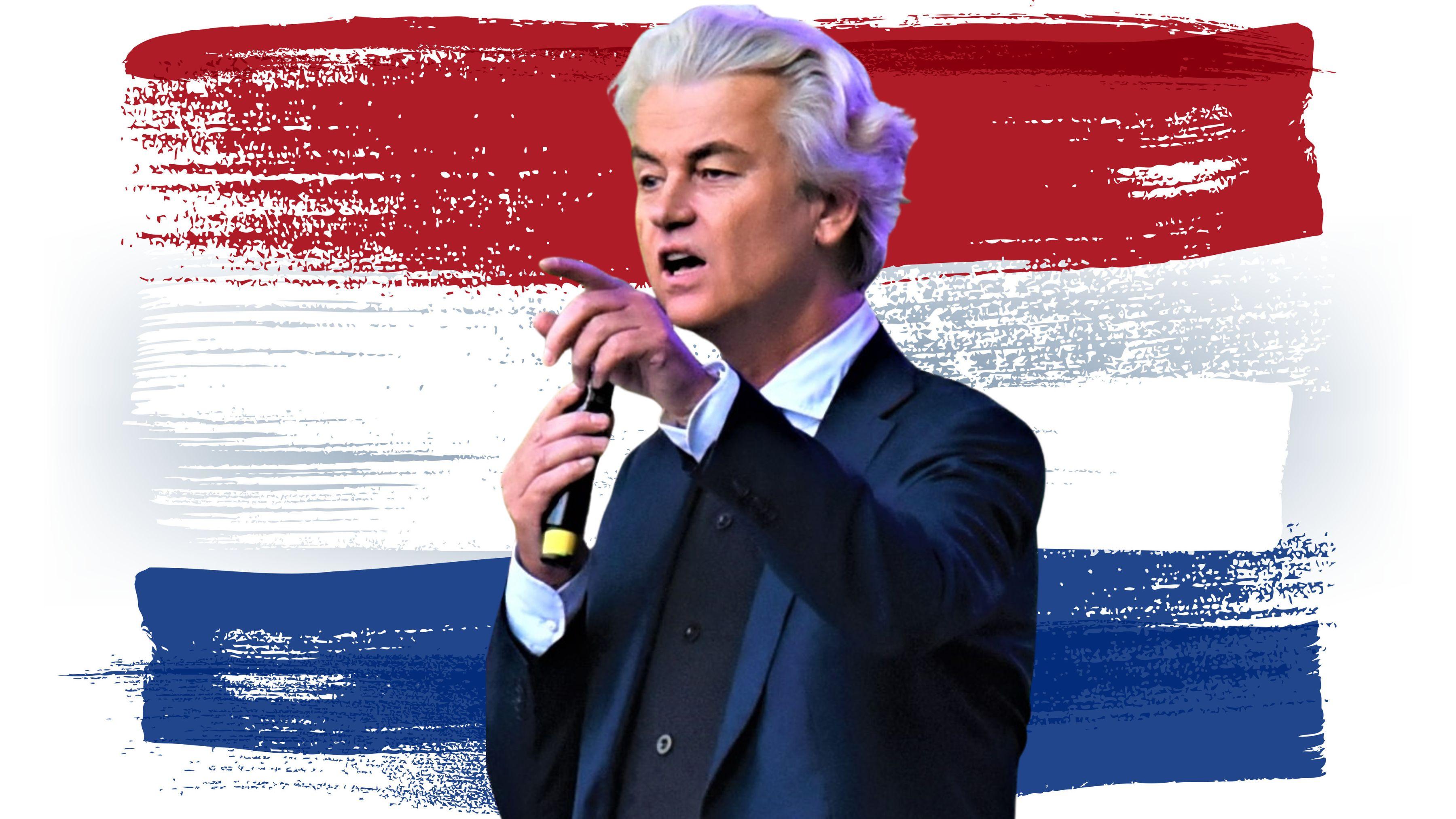Why did so many Dutch voters vote for the far-right Geert Wilders?
The shock victory of the anti-Islam Party for Freedom (PVV) in the Dutch general election of November 22 (2023) is sending tremors across the European Union. The PVV, led by 60-years-old Geert Wilders, who is known for his aggressive anti-Islam, anti-immigration, and anti-EU rhetoric, has suddenly become the biggest political party in the Netherlands, winning 37 seats of the 150 seats in the Dutch lower house (or 23.5% of the votes). This was the sixth general election in which Wilders’s PVV participated, and the veteran politician (who has been a member of parliament since 1998) is now closer to power than ever before. As the leader of the largest party, he will take the lead in forming (and possibly then leading) a coalition government. If this happens, it would signify a normalization of far-right politics in the Netherlands likely to influence political developments far beyond the country.
Coalition talks will be tough
However, it is by no means certain that Wilders will succeed in forming a coalition government. For one, in the Dutch multiparty system (which is based on proportional representation), he has to convince at least two other political parties to join his government. The Dutch process of coalition building can take many months—it took former Prime Minister Mark Rutte a record 299 days or almost 10 months to get his fourth coalition government installed in 2021—and it involves endless rounds of compromises and concessions by all the political parties. Wilders has little experience in the habitual horse-trading that underlies the formation of a coalition government because he has been in opposition forever and also because his political party, the PVV, has but one single member with absolute power: Mr. Wilders himself. Wilders never had to negotiate and what is more, his style has always been confrontational, divisive, and destructive—during the past two decades, he has constantly attacked the Dutch consensus model, insulting and ridiculing politicians from the mainstream parties, while actively sowing social division and inciting hate by scapegoating and discriminating against Dutch Muslims, immigrants, and refugees. Wilders has repeatedly appeared in court for incendiary remarks about Moroccans and Islam, and, in 2016, was found guilty of inciting discrimination; however, the court cleared him of the charge of inciting hatred and imposed no fine or sentence, ruling that a criminal conviction was sufficient punishment for a politician in Wilders’ position.
True, during the recent campaign, Wilders struck a less confrontational tone and signaled a willingness to drop some of his more radical demands in coalition talks. He has publicly promised not to breach Dutch laws or the country’s constitution that enshrines freedom of religion and expression—which, on closer look, are rather empty promises, since none of the other political parties (bar one) would want to join a PVV-led government intended to violate article 1 of the Dutch constitution (on equal treatment of all citizens and non-discrimination). However, not many people find his recent ‘Mother Theresa’ tribute act very convincing. After all, Wilders did not publicly reject his extreme positions on immigration and Islam; he only stated that there are “bigger problems” than limiting immigration at the moment; and, he noted at the same time that his anti-Islam stance will forever remain part of his one-member party’s DNA. Many rightly fear for the future as they expect a ‘Prime Minister’ Wilders to further stoke up divisions, hatred, and tensions in Dutch society—and further normalize and legitimize his anti-liberal agenda.
Following the election outcome, Rutte’s successor as leader of the center-right People’s Party for Freedom and Democracy (the VVD), Dilan Yeşilgöz-Zegerius, has ruled out forming a government under Wilders’ leadership but indicated some willingness to support a PVV-led minority government in parliament. Many VVD voters disagree with her decision. Other parties are still holding their cards close to the chest, although they have signaled a willingness to work with the ‘Mother Theresa’ version of Mr. Wilders. Given the multiparty basis of Dutch governments, it is reasonable to predict that the most extreme elements of Wilders’ party manifesto—including banning the Qur’an, banning Islamic schools and mosques, and banning wearing headscarves in public buildings as well as holding a Nexit referendum (the Dutch equivalent of Brexit)—are not about to become government policy any time soon.
Other European far-right leaders of nativist, far-right, populist parties, including Italy’s Prime Minister Giorgia Meloni (whose party has neo-fascist roots), French opposition leader Marine Le Pen (leader of the National Rally with similar brown roots), Italy’s Matteo Salvini, Hungary’s Prime Minister Viktor Orbán, and Alice Weidel (the leader of Germany’s AfD), were quick to congratulate Wilders. If we go by his ‘friends’, Geert Wilders clearly belongs to the populist, anti-establishment, nativist, and racist far right in Europe which is not just challenging the political mainstream, but is actually transforming the mainstream, gradually but steadily, in its own image. So, what happened in the recent Dutch election?
What changed?
The ruling Dutch coalition government consists of four parties: the conservative VVD; Christian democratic parties CDA and CU; and neoliberal centrist D66. This coalition government had a small majority of 78 seats (out of 150 seats) in the lower house. It is the fourth consecutive coalition government led by VVD leader Mark Rutte. The formation of this coalition government was difficult and political tensions and disagreements within the coalition never subsided. In July 2023, Rutte chose to blow up the coalition over disagreements over refugees—thereby making the asylum and migration crisis the key item in the November election. This, of course, directly played into Wilders’ hands—also because Rutte himself decided to retire from Dutch politics: the majority of Dutch voters had grown tired, after 13 difficult years, of Rutte’s style of doing politics.
Rutte’s political gamble to call an election backfired: his party (VVD) lost 10 seats in parliament (Table 1). In fact, all parties involved in Rutte’s fourth and final coalition government lost vote share: taken together, the four parties lost 39 seats or 23 percent of the voters. Where did these voters go? The three winners of the November election are Wilders’ PVV, the center-right Farmer-Citizen Movement (BBB), and a new center-right party, called New Social Contract (NSC), led by former-CDA member of parliament, Pieter Omtzigt. The PVV gained 20 seats (compared to 2021), the farmers’ party grew by 6 seats, and newcomer NSC entered the Dutch lower house with 20 MPs (Table 2). All three parties mobilized the anger of voters who had become fed up with Rutte’s government(-s) and policies, but each tapped into this societal anger in its own manner.
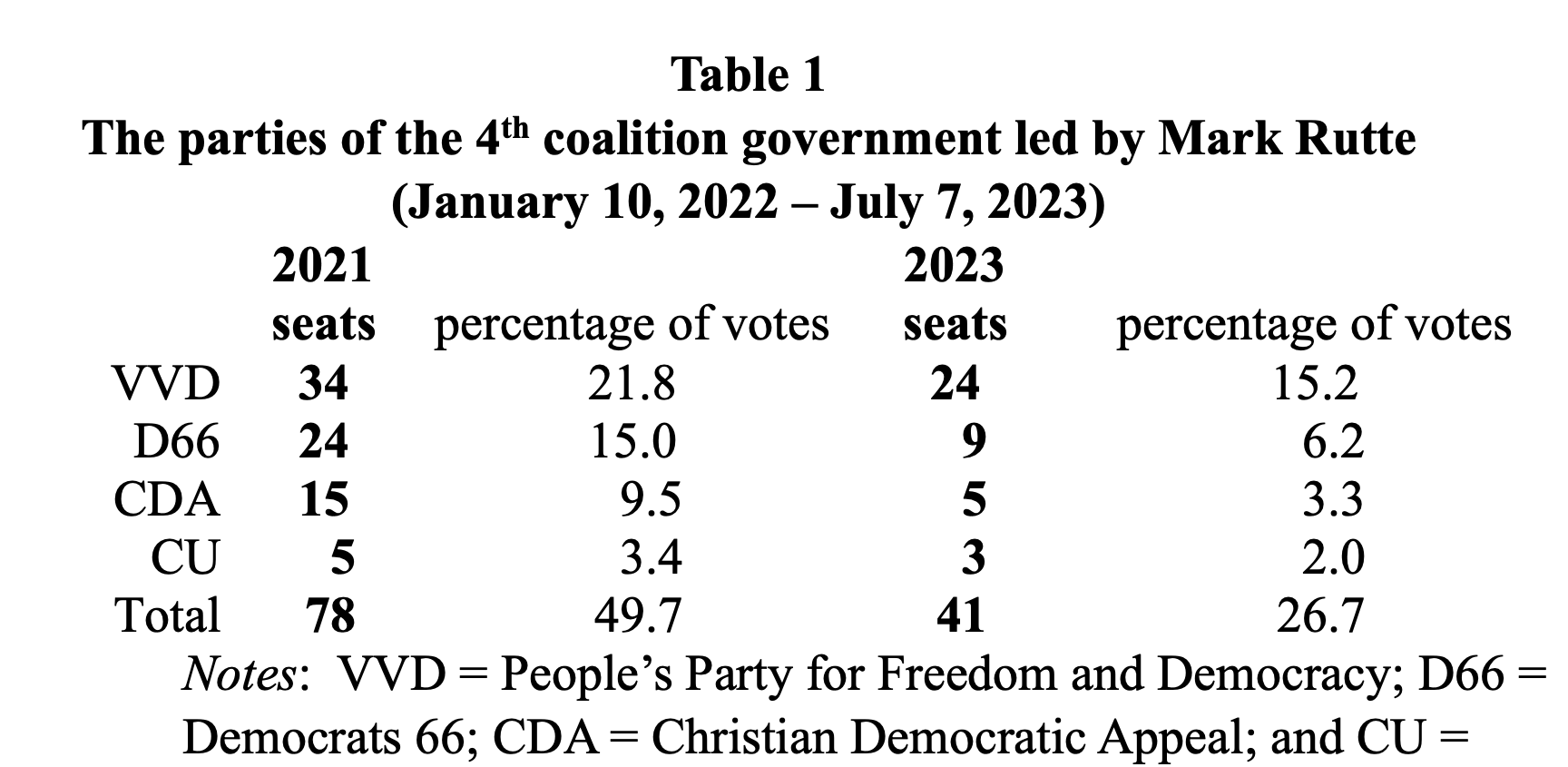
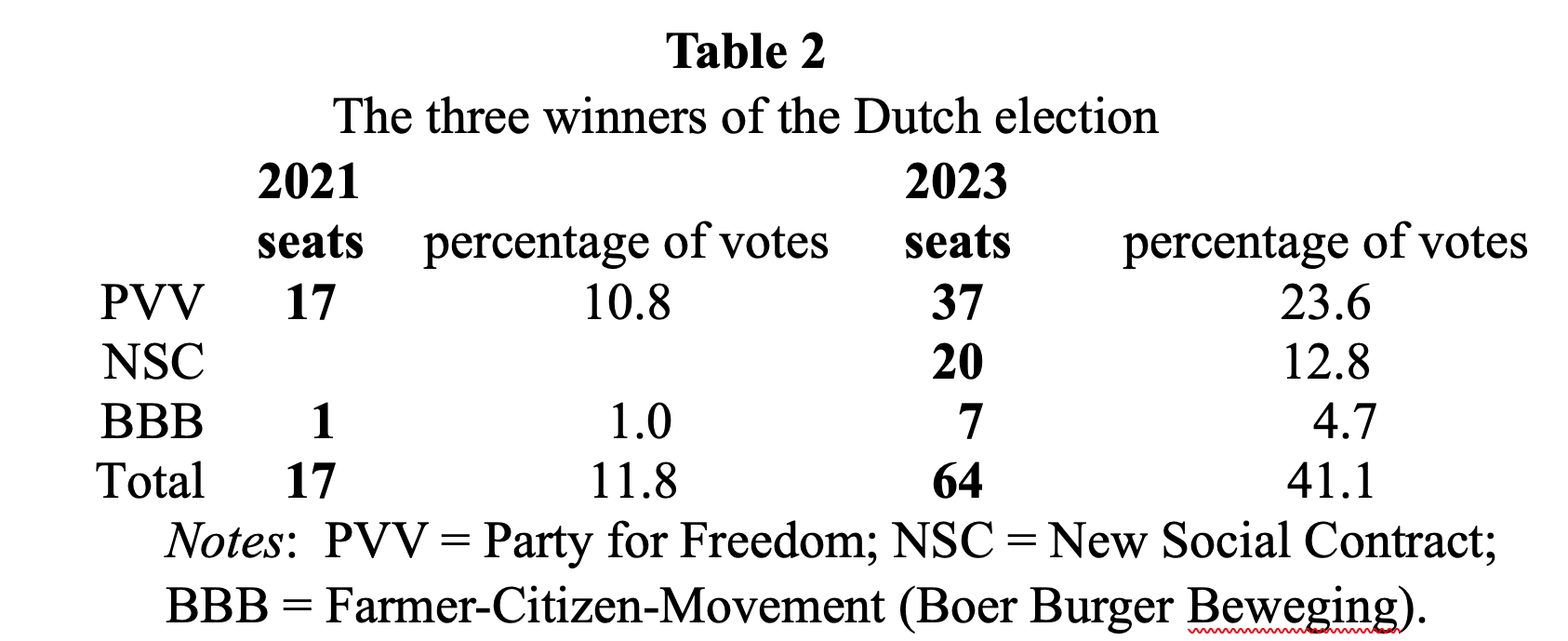
As Figure 1 shows, 15% of PVV voters supported the VVD in 2021. This is a big shift: out of the 10 lower-house seats lost by the VVD, 6 went to the PVV. Two other coalition parties, the CDA and D66, taken together, lost 3 seats to the PVV. In addition, other far-right parties lost 5 seats to the PVV, while Wilders succeeded in motivating many people who did not show up in the 2021 election to vote for his party (adding another 4 seats).
Exit polls show that the 2023 PVV voters are quite representative of the overall Dutch electorate. The PVV attracted the largest number of young voters of all parties: 17% of voters between 18-34 years voted for Wilders (and his popularity under the 16-18 years old, worryingly, is even higher). 47% of PVV voters are women; 53% are men. Around 10% of highly-educated voters supported the PVV (implying that more highly-educated voters chose the PVV than D66, which in the past attracted the higher educated). The PVV made major gains in cities as well as in rural areas—along with the BBB and NSC.
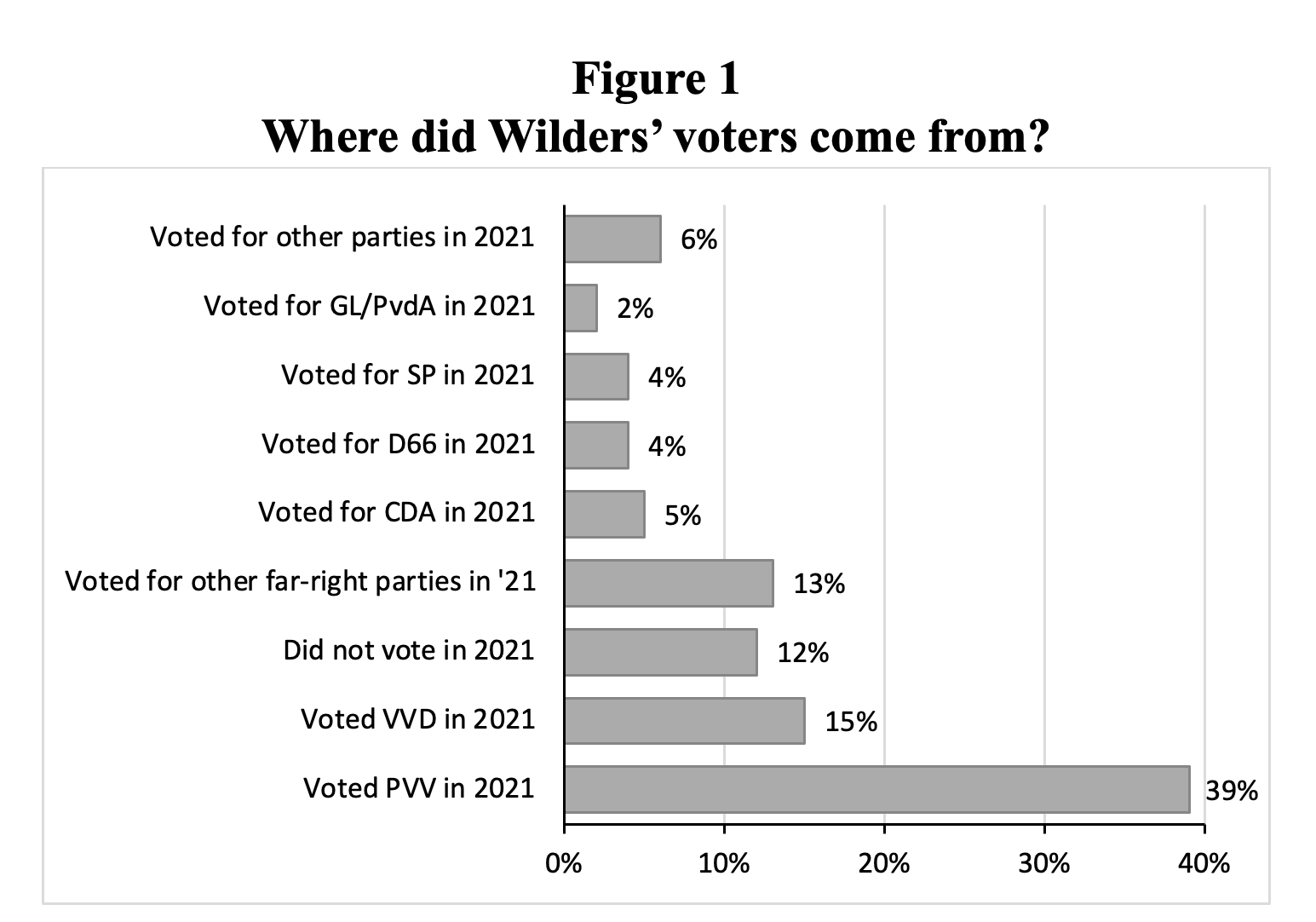
The extreme volatility of the preferences of Dutch voters
A defining feature of the 2023 election has been the sharp swings in voters’ choices in the run-up to November 22, 2023. Wilders’ victory was so unexpected because all opinion polls up to November 15 (i.e., less than one week before actual election day) were showing that the PVV would only about manage to maintain the same number of seats in the lower house it had won in 2021 (i.e., 17 seats). This is shown in Figure 2. Then, in the seven days before election day, Dutch voters massively switched to the PVV, though the final polls, published on November 21, still suggested ‘only’ 27 seats for the PVV—far below the 37 seats it actually won.
It can be seen from Figure 2 that many voters who on November 15 expressed an intention to vote for NSC and BBB, switched to the PVV at really the last minute. Similarly, many voters who were leaning toward the VVD moved to the PVV.
This last-minute switch to Wilders was likely triggered by three factors. First, as mentioned above, Wilders reached out to more voters by striking a decidedly less confrontational tone. The strategy was so successful that the rarely critical Dutch media began to refer to him as “Geert Milders.” Second, in August, VVD leader Dilan Yeşilgöz-Zegerius had signaled that the VVD was open to a potential coalition with Wilders’s party, but under her prime ministership. This was a major break with the past, as Mark Rutte had earlier ruled out collaborating with Wilders. This time, Wilders would not be side-lined, and hence, unlike before, a vote for the PVV would not automatically end in the opposition benches. Yeşilgöz-Zegerius, therefore, brought Wilders in from the cold. Third, in an otherwise low-profile campaign, Wilders benefited from televised election debates in which he was allowed to dominate the discussion—his insults and ad hominem attacks never fail to push up TV ratings. At the same time, he was given space to show his softer side by cuddling his cats in a children’s TV news program.
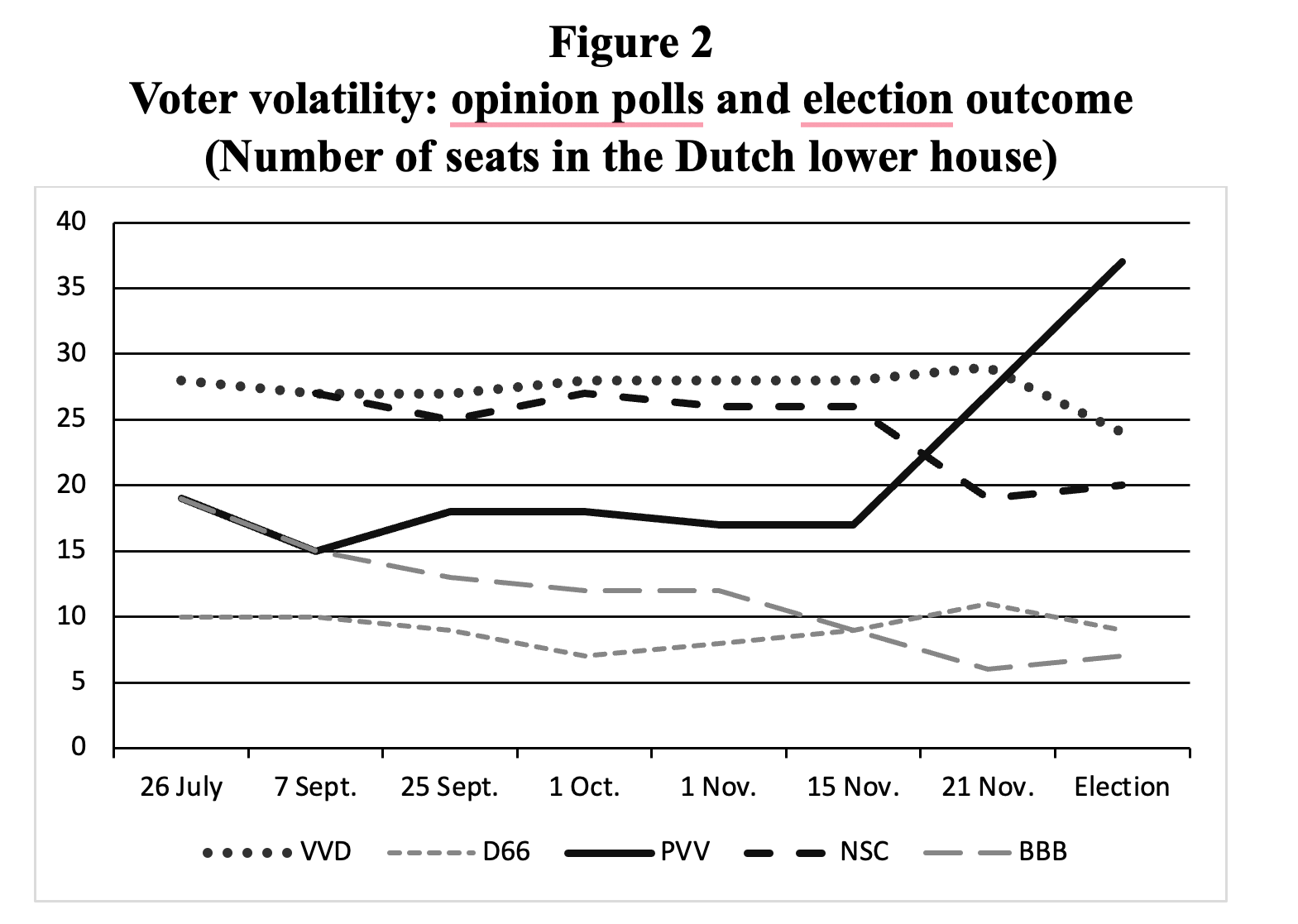
Source: Ipsos Politieke Barometer; https://www.ipsos.com/nl-nl/politieke-barometer Notes: Opinion polls were published in July, September, October and November 2023.
This last-minute shift to the PVV is, in my view, a sign that many did not vote for the PVV because of Wilders’ aggressive anti-Islam stance or his anti-immigration rhetoric—after all, a less-confrontational Wilders had made it clear that the Dutch have bigger problems right now. Most voters are struggling with the cost-of-living crisis (intensified by the 2021-2023 surge in inflation), economic precarity, a shortage of affordable housing, and the unequal burden-sharing of the costs of climate mitigation policies. As a perennial outsider and populist critic of the ‘ruling elite’, Wilders could also easily tap into the gulf of popular anger, caused by the utter lack of accountability and transparency of public policymaking under Rutte’s governments. The BBB and NSC campaigned on exactly the same issues—but Wilders profited from a last-minute bandwagon effect: after opinion polls began to show a rise in the vote share of the PVV, many—right-wing—voters switched to the candidate they expected to win.
This bandwagon effect is visible in Figure 3. It can be seen that the combined vote share of the PVV, the BBB, and NSC from early September 2023 until election day was rather stable at around 40% or 60 seats in the Dutch lower house. These 40% of voters must be considered to be right-wing protest voters who have lost confidence in the mainstream center-right parties. In the final week before the November 22 election, Wilders managed to persuade many of them to support his party. Media treatment (including TV debates) certainly strengthened this bandwagon effect. It also helped Wilders that Mr. Omtzigt, the leader of NSC, had a firm preference for leading his party from the lower house rather than becoming prime minister in the event of his party becoming the largest in the Dutch parliament. Mr. Wilders has no such hesitations.
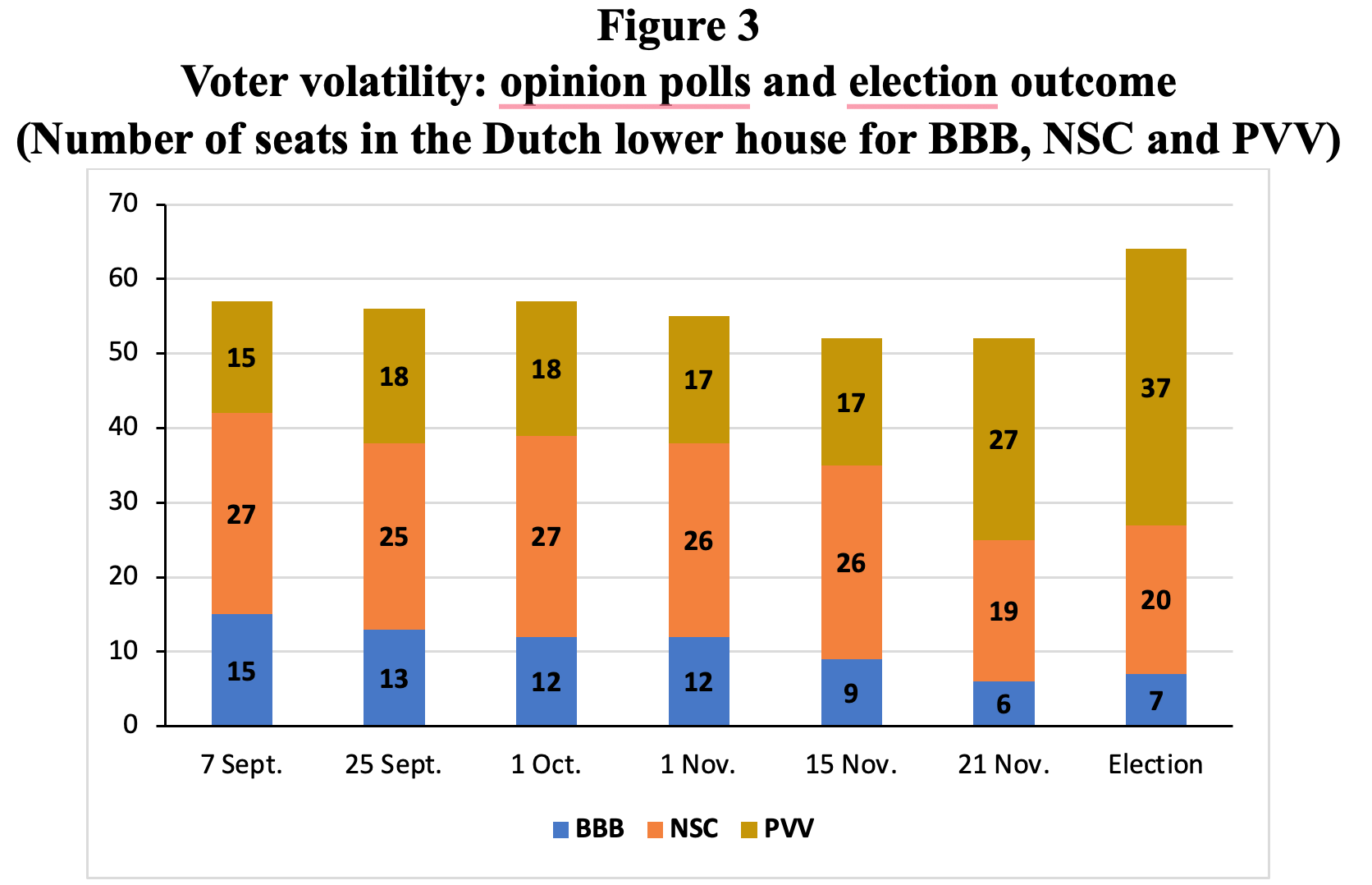
Source: Ipsos Politieke Barometer; https://www.ipsos.com/nl-nl/politieke-barometer. Notes: Opinion polls were published in July, September, October and November 2023.
What happened to the Dutch Left?
The victory of the PVV reflects a painful failure of the Dutch left and center-left parties to persuade the Dutch electorate to support a progressive alternative to the ruling centre-right coalition government. The combined Left did not increase its voting strength compared to the election in 2021 (Table 3). This is all the more remarkable because the ‘hot button’ issues for voters in 2023 were themes on which the Left traditionally used to be strong: the cost-of-living crisis, economic precarity, and the lack of affordable (social) housing. But the Dutch Left failed to win on what used to be its ideological home turf. In fact, a considerable number of voters who had supported the Socialist Party and the Labour Party in 2021, now voted for the PVV or NSC. What explains this failure of the progressive parties to win the hearts and minds of voters over the cost-of-living crisis and the housing crisis?
The lack of support for the Left is a longer-term problem. In fact, the support for the combined Left in the Netherlands has been in a structural decline in recent years. The combined vote share of the Labour Party (PvdA), Green Party (Groen Links), Socialist Party (SP), and Party for the Animals (PVVD) was around 36% during the 1990s, 37% during 2003-2010 and 36% during 2010-2017. However, it fell to 23% in the election of 2021 and remained at 24% in the election of 2023. To reverse the structural decline, the Labour Party and the Green Party decided to campaign based on a joint list and one leader: the polyglot Frans Timmermans, who left his job as European Commission vice-president responsible for the EU Green Deal to return to Dutch politics to fight the election on a platform of social and climate justice.
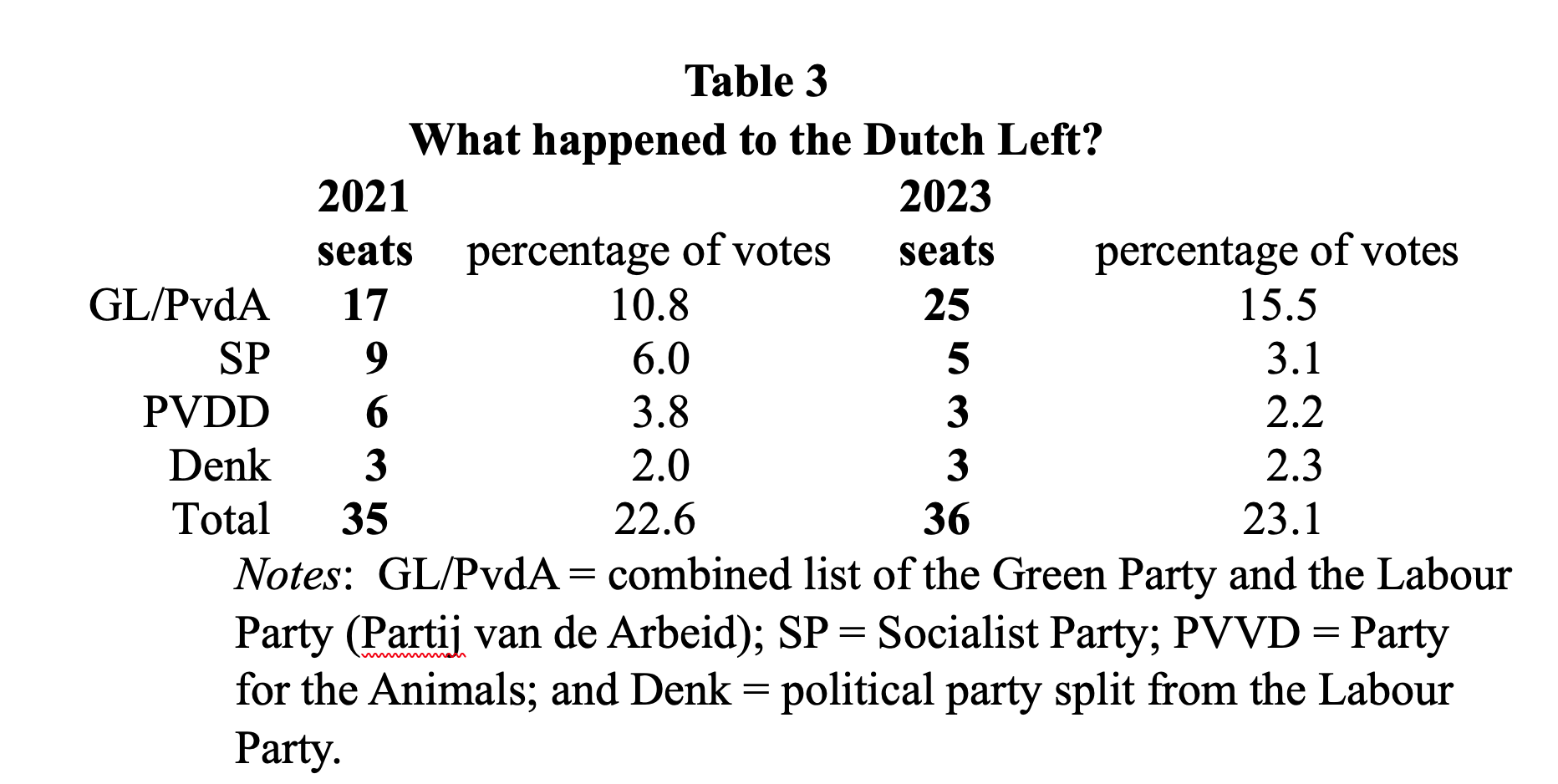
Mr. Timmermans’ jump did not pay off. True, the combination of Labour and Greens gained 8 seats (compared to 2021) and now has 25 members in the lower house (i.e., one-sixth of the MPs). But the gain of GL/PvdA has come at the cost of a significant decline by 7 seats in the vote share of the other (more leftist) parties. Crucially, many left voters decided to vote ‘strategically’, i.e., they voted for the biggest left-wing party in order to create a larger progressive opposition force against Wilders. The bandwagon worked as well on the left of the political spectrum and drained the smaller left-wing parties of votes on election day. While the combined Left did neither win nor lose, the traditional center (consisting of the Christian Democratic parties CDA and CU plus D66) lost vote share—from 29% of votes during 2017-2023 to only 11% of votes now. Omtzigt’s center-right NSC and the BBB welcomed most of the voters leaving the traditional center—and must be considered the successor parties to the CDA, which had dominated the Dutch political center ever since World War II.
Why did Wilders gain so many votes?
Some key reasons why Wilders gained so many votes have already been mentioned: he profited from friendly media exposure; VVD-leader Yeşilgöz-Zegerius brought him back from political exile; he benefitted from the bandwagon effect operating on the (far) right side of the Dutch political spectrum (Figure 2 and Figure 3); and because the Left spectacularly failed to win votes over the cost-of-living and the housing crises (Table 3). Wilders surfed to electoral victory on the mobilization of popular anger on these issues, as did the BBB and NSC (see Table 2).
But there is more to the story of why Dutch voters turned so massively to the right. Rather like the election of Donald Trump in 2016, 2023’s shocking outcome is rooted in the structural failure of Dutch mainstream political parties to address the—often justified—popular anger on key issues including the shortage of affordable housing, the cost-of-living crisis, the lack of accountability and transparency of public policymaking, and major uncertainties concerning the burden sharing of the social costs of environmental and climate mitigation policies. All these issues are interrelated, but three of them stand out.
“Teflon Mark” and the decline in democratic accountability
A string of serious government scandals throughout the four consecutive coalitions headed by VVD leader Rutte, who became known as “Teflon Mark” for his ability to survive them, goes a long way to explain popular dissatisfaction with the mainstream parties and the appeal of Wilders as well as of Pieter Omtzigt (NCS) and BBB-leader Carolyn van der Plas. The litany of scandals is simply too large to review here, but two stand out: the child benefit scandal in which more than 20,000 families were wrongly accused of benefit fraud, many on the basis of ethnicity; and the Groningen gas-field earthquake scandal.
Under heavy right-wing pressure to prevent ‘welfare fraud’, the Dutch Tax Office (falsely, as became clear only much later) accused thousands of parents of making fraudulent claims for childcare benefits. The Tax Office required them to repay these benefits, often amounting to tens of thousands of euros, in their entirety. The parents who were falsely blacklisted for benefit fraud and in some cases were bankrupted by the benefit repayments disproportionately had backgrounds as 1st and 2nd generation immigrants or dual nationality. The algorithms used by the Tax Office to identify fraud cases were—in hindsight—found to be systematically biased and discriminatory, targeting and punishing certain groups in Dutch society.
The Ministry of Finance has recently officially acknowledged that institutional racism played a major role in the Tax Office’s decision-making in these cases. The childcare benefit scandal led to an official Parliamentary Interrogation which concluded that fundamental principles of the rule of law were violated. During the interrogation, Rutte repeatedly claimed that he could not recall relevant facts, famously stating that he had “no active memory” of his own earlier statements; he also had to acknowledge erasing text messages on his phone in violation of legislation. The Interrogation also brought to light the so-called ‘Rutte doctrine’. According to this doctrine, Ministers were urged to only reluctantly share relevant information (including policy discussions between civil servants and ministers as well as between ministers) with the members of the lower house—a deliberate strategy to limit the power of the lower house to scrutinize government policy.
In addition, Rutte’s coalition governments were built on long and detailed agreements between the coalition parties and on a strict parliamentary discipline to stick to these agreements. As a result, a majority of members of parliament, namely all those MPs of the coalition parties, would generally rather sheepishly support the ruling government—which not only compromised the role of parliament as a critical check and counterbalance to the legislative power of the Rutte governments, but it also provided space to Mr. Wilders to step up and act as the leader of the opposition. Wilders cunningly exposed the lack of functional dualism between parliament and government and the (otherwise not public) horse-trading between the coalition partners. In the end, the political consequences of the child benefit scandal were rather mild, but the lives of many of the thousands of families that were falsely accused were ruined. Adding insult to injury, the Dutch government has so far been incapable of financially compensating the victims of this scandal—which outraged many voters.
Another government failure that undermined public trust in government and the parliamentary system, was the Groningen earthquake scandal. Since the early 1990s, nearly 1,000 man-made earthquakes, caused by the extraction of gas from the Groningen gas field, damaged houses and farms, leaving residents in constant fear and with huge cost of repairing properties, while the market value of their properties plummeted. The two oil companies, Shell and Exxon Mobil, extracting the gas, and the Dutch government, for two decades, denied responsibility for their actions and ignored the voices of citizens and scientists. A Parliamentary Inquiry Commission concluded (in February 2023) that the affected residents had been badly treated by the Dutch state which owed them a “debt of honor.” The Groningen earthquake scandal left a deep scratch on “Teflon Mark.”
The popularity of Pieter Omtzigt is largely due to his role in uncovering official wrongdoing in the childcare benefit scandal. Omzigt’s new party NSC, campaigned on improving governance, making government more transparent and accountable, and strengthening the power and democratic legitimacy of parliament. The key plank of Omtzigt’s party’s manifesto centered on remedying the weaknesses of the scandal-ridden Dutch political system, many of which can be blamed on Rutte’s approach to governing over thirteen years. But the scandals and the lack of political accountability also provided Wilders with an open goal: “Teflon Mark” offered him the opportunity to criticize the political elite and call for popular sovereignty, since “Henk and Ingrid”, which is how Wilders names his typical voters, were clearly not amused.
Farmers, nitrogen wars, and climate change
The political parties included in Rutte’s third and fourth governments succeeded in further alienating and upsetting many—mostly rural—voters by completely mismanaging the crisis on Dutch nitrogen emissions and even triggering a ‘nitrogen war’. According to EU legislation, EU-27 member states have to protect the ecosystems of designated nature reserves (known as the Natura 2000 areas). In 2019, the highest administrative court in the Netherlands concluded that the Dutch nitrogen permits system was failing to prevent emissions harming these reserves within its borders and ruled that this practice needed to end immediately. Agriculture, and intensive livestock farming in particular, was considered responsible for an estimated 80% of emissions of one form of nitrogen pollution. Hence, to meet EU norms, drastic cutbacks on agricultural production by 2030 were proposed. Many (livestock) farmers were told to scale down, with many of them likely to have to fully shut down their farms.
Not surprisingly, this enraged farmers, who felt mistreated, because, for decades, government policies had encouraged them to intensify production and produce more and more, no matter what the environmental costs. The Netherlands is the second largest agricultural exporter in the world after the US on a fraction of the land. On a population of 17.6 million people, we have 11.4 million pigs, 3.8 million cows, and 99.9 million chickens which emit carbon, nitrous oxide, and methane (a very potent greenhouse gas). Many Dutch farmers operate at low margins and heavy debt burdens. Now they were being told to scale down. Other high-polluting industries, such as aviation (Schiphol), construction, and transport, have yet to face such severe environmental rules.
It does not take a Ph.D. in public policy to recognize that the Rutte government made a mess of the nitrogen issue. When the Dutch government announced plans to buy out farms close to nature reserves and cut the country’s livestock herd by as much as one-third, farmers revolted, staging massive farmers’ protests that have shaken Dutch politics to its foundation. In these farmers’ protests, furious farmers were withholding deliveries from grocery stores and blocked highways with burning hay bales and tires. The announcement lit the larger countryside up on fire and brought to light a broader divide between the rural and urban Dutch. Many people living in rural areas sympathize with the farmers’ plight and feel abandoned by the government, as public services (including hospitals and schools), public transport, and healthcare provisions are whittled away in their areas. The political backlash is showing up in the ballot box—with large gains for the farmer-citizen movement BBB, NSC, as well as Wilders’ PVV which are all critical of the government’s nitrogen policy policies, and large losses for the traditional center-right parties.
What is important is that the protest parties PVV, NSC, and BBB tapped into the rural discontent, but did not create it. The discontent is fully the responsibility of the successive Dutch governments, which included the CDA, the VVD, and Labour, which for decades promoted a highly polluting, intensive bio-industry, prioritizing production and exports over environmental issues, and now chose to ignore the fact that the costs of environmental policies fall disproportionately on rural people rather than on urbanites. The consequences of this neglect have become visible today.
The nitrogen crisis is also bad news for climate policy. If the Netherlands is to meet the EU-wide CO2 emission reduction target of 55% by 2030 (compared to emissions in 1990), then it needs to implement some drastic actions—including a reform of its industrialised agriculture which is responsible for 16% of Dutch greenhouse gas emissions. The restructuring of the Dutch economy and the green transition will have costs (and benefits) which have to be shared in ways that are feasible and acceptable for all actors involved. Similar to the yellow vests’ protestations in France, the Dutch farmers’ protests are stirring thorny debates on the distributional impacts of climate policies, with implications that go well beyond the Netherlands. Mr. Timmermans, the leader of Labour and the Greens, campaigned on a just green transition—but his arguments fell flat in a toxic environment in which the Dutch were trying to come to terms with extremely high energy prices (in 2022), the rural-urban fall-out of the nitrogen wars, and a not-so-trustworthy state that was officially indicted for having violated the rule of law. Climate action is unlikely to become popular in such a context.
This is showing. So far, the Dutch are considerably running behind schedule in terms of climate action. In 2021, the Netherlands’ Environmental Assessment Agency (PBL) sounded the alarm that the country would likely miss the 2030 target. Two years later, in April 2023, Climate Minister Rob Jetten (D66) said that the Netherlands had been missing its climate goals for years. The share of renewable energy sources in the energy mix of the Netherlands in 2022 is only 14.7%, which is considerably below the average share of 22.5% for the EU-27. Comparable countries like France (20%), Germany (20.4%), Denmark (36.7%), Finland (43.7%) and Sweden (64.7%) score much better on this indicator. The more the Dutch are running behind, the more drastic policy action will be needed—which, in turn, means that stronger coordination and cooperation between the state, citizens, firms, and political parties becomes necessary to achieve an acceptable sharing of the burden of the unequal social costs caused by the green restructuring. All this gives Mr. Wilders further means to mobilize popular anger in his support. The PVV is not bothered by climate change. According to Wilders, the climate is always changing and the enterprising Dutch have always managed to adapt to such changes. For the PVV, there is no need to lower CO2 emissions. One can reasonably expect that a Wilders-led government will roll back already implemented climate policies and will not, or only very reluctantly, support the Green Deal proposed by the EU.
However, even if Wilders’ position is extreme, he is not alone in his climate-scepticism. Other parties including the farmers’ party BBB, the CDA, NSC, and also the VVD are unwilling to move forward with more ambitious climate plans, and this will be true even in a coalition government in which the PVV does not feature. Around two-thirds of the MPs in the new Dutch lower house do not feel much, or any, urgency concerning climate change—which explains why the Netherlands is not a leader, but a laggard, in the zero-carbon transition in the EU. It is not a coincidence that fossil-fuel industries (including KLM, Shell, and Tata Steel) receive between €39.7 billion and €46.4 billion per year in subsidies and tax benefits, according to official estimates of the Dutch Ministry of Economic Affairs and Climate (2023). This is roughly six times more than what the Dutch government is spending on renewable energy subsidies each year. These numbers reveal the true preferences concerning climate policy of the successive Rutte governments. The bottom line is that Dutch politics is failing to prioritize climate action more generally; Wilders’ stance on climate policies is certainly extreme, but unfortunately not so distant from the Dutch mainstream as many may like to think.
Immigration and welfare chauvinism
In July 2023, VVD leader Mark Rutte decided to pull the plug on his fourth government over the specific issue of asylum seekers. This was a deliberate and cynical attempt to shift public attention away from the nitrogen crisis and the rural-urban divide, and back to immigration and the alleged native-immigrant divide. Doing this, Rutte’s VVD hoped to dominate the campaign. Instead, as happens always, the far-right PVV dominated the immigration debate—by making false promises to limit “the tsunami of refugees” coming to the Netherlands by opting out of European treaties and immigration directives. As the British Brexit Conservatives have discovered, civilized countries have pledged to adhere to international laws and directives concerning migrants and refugees. So far, post-Brexit, UK net immigration has more than doubled. Hence, unless the Netherlands leaves the European Union, the Council of Europe, and UN conventions, Wilders’ options are limited.
Rutte’s gamble was deeply opportunistic and dangerous. Immigration, after all, is posing real challenges for EU countries. In 2022, there were just under one million applications for asylum in the EU, 52% more than in 2021 and the highest level since 2016. This number does not include the millions of Ukrainian refugees who fled the war. Around 330,000 persons illegally crossed the border into the EU and around 1400 people were reported dead or missing along the Mediterranean crossing in 2022. This growing number of refugees and asylum seekers is caused by global economic inequalities, wars (in Syria, Afghanistan, Somalia, Sudan, Ukraine, and Palestine), and climate change—which are all drivers in which the rich countries play a major role. The arrival of large numbers of refugees and irregular migrants puts the EU asylum system under great stress—as member states do not agree on a balanced distribution of and sharing of financial responsibility for asylum-seekers. Pictures of the humanitarian crisis in refugee camps in Greece and Italy dominate the news—and add to the feeling that the refugee crisis is spiraling out of control. The Dutch news is dominated by reports on overcrowded centers for asylum seekers in which many of those seeking asylum have been forced to sleep in the open air, as tents have been banned as they impede the view of CCTV. According to Amnesty International, the centers are unsanitary and fail to provide adequate food, healthcare, privacy, or proper protection from the weather. The Dutch Council for Refugees felt prompted to sue the state over what it calls the “inhumane” treatment of newcomers, while at the same time, many residents of small towns have been protesting against the establishment of asylum seekers’ centers in their towns.
Wilders’ extremism on this point has to be put in context. For one, consider the British Conservatives who are obsessed with refugees crossing the Channel in small boats—and seem willing to violate international law in order to implement a scheme in which refugees arriving on British shores are deported to Rwanda (which is not generally known to be a safe third country). This is done by what still is supposed to be a mainstream political party. Or consider Denmark where the social-democratic government has paused its plan to send asylum seekers to Rwanda. Sweden’s right-wing government (which includes the far-right Sweden Democrats, but also three mainstream parties) is scaling back immigration, by making family reunions more difficult and by signaling that the country is not welcoming refugees. The European Commission got its hands dirty by striking a deal with Turkey in 2016, aiming to send migrants who failed to win refugee status back to Turkey. Turkey’s President Recep Tayyip Erdoğan ended the deal in March 2020 when he encouraged thousands of asylum seekers to enter the EU, via Greece, sparking a border crisis that further soured the NATO allies’ already strained ties. In June 2023, Mark Rutte joined far-right Italian Prime Minister Giorgia Meloni and European Commission President Ursula von der Leyen on a mission to Tunesia to set up a €1 billion agreement with President Kais Saied aimed at stemming migration to Europe from Tunisia. Tunesia’s poor human rights record and the increasingly authoritarian nature of Saied’s regime were conveniently ignored. The deal suffered a major setback as President Saied rejected financial support from the EU and refused to let a delegation of members of the European Parliament enter his country to meet representatives of civil society organizations, trade unions, and political parties to discuss the pact.
The picture is quite ugly, but the challenges are real. In the Netherlands, Wilders is not alone in calling for taking back control of immigration. Wilders is still more extreme than the mainstream parties, but the differences between him and the political center-right are becoming smaller. Omtzigt’s NSC wants an immigration cap maybe as low as 50,000, for all categories of immigrants: asylum seekers, foreign workers, and foreign students. BBB, CDA, and VVD want to drastically cap immigration as well. These are empty promises because legal options to cap immigration are limited by EU and international law. But these promises are performative because they reinforce the native-immigrant divide—and easily align with the ‘welfare-chauvinist’ narrative of a struggle over scarce resources between the “deserving” (native Dutch) and the “undeserving” (the migrants). All right-wing political parties feed this narrative—in an attempt to mobilize voters for their cause. But Wilders has an advantage in the immigration debate, because he can more strongly champion a ‘welfare chauvinist’ position than the others. Wilders campaigned blaming migration and refugees for high taxes, the housing shortage (and high housing rents), and increases in crime rates and arguing that ‘Henk and Ingrid’ should be helped by the state (while remaining silent on ‘Mohammed and Fatima’).
Implicit in this welfare-chauvinist narrative is the assumption that (public) resources are scarce: Dutch taxes are too high; the public debt is a problem; and fiscal austerity is the norm. What is left unmentioned is that the Dutch income tax and social security system is not progressive, but regressive: official numbers published by the Netherlands Bureau of Economic Policy Analysis (2022) show that the strongest shoulders carry a lower burden than the weakest. Not mentioned is the fact that owner-occupied housing is strongly tax-favored and in many cases effectively subsidized and that capital gains are taxed under the lower wealth tax scheme and not under the higher income tax (IMF 2021). The fact that the Netherlands belongs to the top-four jurisdictions that function as tax (avoidance) havens for multinational corporations and wealthy individuals, facilitating illicit financial flows and corporate profit shifting to tax-free territories, did not play any role in the election debates. Tax havens drain an estimated $151 billion from global tax coffers through corporate profit shifting (The State of Tax Justice 2023).
What is also left unmentioned is that Dutch corporate profits have grown to record levels, while the labor income share has gone down; profiteering contributed significantly to the Dutch cost-of-living crisis but was not a ‘hot button’ issue in the election (Storm 2023). And what about the (social) housing crisis? Well, decades of neoliberal government policy have promoted home ownership and left building to the market—which resulted in a current housing shortage of 391,000 homes. Insufficient construction of affordable houses is the problem, but stepping up building takes time, especially because building leads to nitrogen pollution and, hence, EU nitrogen regulations prohibit a significant expansion of housing construction. This poses a dilemma for the green combination of Labour and the Greens. House prices have exploded and the average home now costs more than 10 times the modal income. A quarter of renters struggle to pay the rents and class differences have become more pronounced. The Netherlands had a rich tradition of social housing, but especially in the last decade, during the Rutte governments, policy-makers have decimated housing corporations. Wilders is blaming immigrants for the shortage of affordable housing, but the real cause is decades of neoliberal policies. The Netherlands is a very rich country and there are no real insoluble shortages: the existing shortages have all been created by deliberate (neoliberal) policy decisions by various Dutch governments, which can be changed—if we want to do so. Hardly any of the mainstream parties acknowledge the true state of affairs, by which they are—again—offering Wilders a political vacuum to fill.
In lieu of a conclusion
The shock of Wilders’ election victory is still fresh and, with time, we will hopefully be able to better understand why so many Dutch voters voted for his party. This note offers only a provisional account, arguing that Wilders’ success must be considered as part of a larger protest vote, in which (rural) Dutch voters expressed their frustration and anger with key mainstream parties and the overall democratic deficit. The electoral gains of the NSC and the BBB underscore this conclusion. The vote for Wilders does not reflect a sudden rise in xenophobia or Islam hatred in the Netherlands, although it must be recognized that Wilders’ extremism did not discourage people from voting for him.
Wilders’ victory does, however, suggest the breakdown of the Dutch consensus politics: the political center that has been unmissable to bridge the center-left and center-right divide has collapsed; the Left has stagnated; and the (far) right now holds a majority. In view of his destructive and confrontational inclinations, Wilders will continue to undermine the now ailing consensus culture—the resulting polarisation will change Dutch politics at its foundations, even if (or particularly if) Wilders fails to form a coalition government. It is difficult to imagine a Prime Minister Wilders attending EU meetings and doing diplomacy, but the examples of Giorgia Meloni, Boris Johnson, Silvio Berlusconi, Donald Trump, and Viktor Orbán show that this is simply due to a lack of imagination.
It remains strange that no one really challenged Wilders’ economic populism. In 2016, the Socialist Party analyzed the voting behavior of the PVV in the lower house and found that Wilders’ party voted against lower house motions to stop the further liberalization of the Dutch housing market, to protect the working conditions of care workers, to impose a wealth tax and to subsidize legal aid for low-income households. The PVV also voted against motions to put a halt to market competition in healthcare, to raise support for the chronically ill and the elderly, and to raise taxes and stop corporate tax evasion. Wilders is combining a neoliberal economic agenda with a few populist measures of a welfare-chauvinist nature and remains silent on the former while trumpeting the latter. His agenda is not progressive. It is important to expose the essential neoliberal ideology underpinning the PVV’s manifesto—and to show that it is not in the interest of Henk and Ingrid.
At a general level, the victory of Wilders indicates that after four decades of neoliberal (economic) policies, we have reached the end of the road. Neoliberal (economic) ideology is based on TINA: “There Is No Alternative” to fiscal austerity (with low taxes) and fiscal policy rules, independent central banks, deregulated labor markets, down-sized social security, high inequality, market-based meritocracy, liberalized financial markets that operate without borders, and neglect for the environment and climate. This ideology has reached its limit and is under immense pressure from climate change, geopolitical conflicts, and income and wealth inequalities that have spiraled out of control. The result has been a far-right political backlash, in Polanyian fashion because the far right is (about) the only one providing an alternative, namely “The America First” alternative. Four decades of (economic) neoliberalism have left most mainstream parties (including those of the Left) brain dead. What is the (economic) alternative they can offer? Mainstream parties must act. But as long as TINA continues to rule in political and economic thinking, the far right will continue to gain. Wilders is therefore just the Doppelgänger of mainstream political parties. Getting rid of that Doppelgänger will mean getting rid of neoliberal economic thinking.
